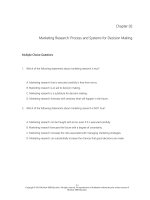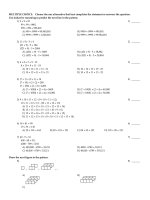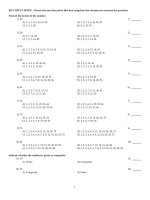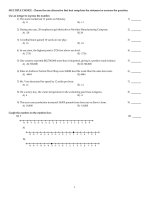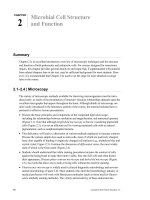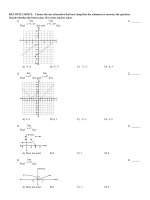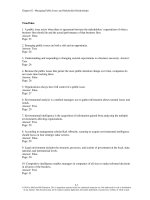Business law with UCC applications 14th edition sukys test bank
Bạn đang xem bản rút gọn của tài liệu. Xem và tải ngay bản đầy đủ của tài liệu tại đây (332.81 KB, 41 trang )
Chapter 02
Sources of the Law
True / False Questions
1. The primary objective of law is to maintain harmony, stability, and justice within a society.
True
False
2. The law is a delicate balancing act between the power of the state and the rights of individuals.
True
False
3. Trade-offs rarely occur within the law.
True
False
4. The language of the law helps in the execution of the law.
True
False
5. In his book, Law and History, Professor Anthony Chase writes that the balance between the spirit
and the letter of the law is one of the most obvious dualities in the law.
True
False
6. According to the uncertainty principle, when intent and results coincide, it is usually based on the
strategic thinking and experience of the persons involved.
True
False
2-1
Copyright © 2017 McGraw-Hill Education. All rights reserved. No reproduction or distribution without the prior written consent of
McGraw-Hill Education.
7. The Articles of Confederation created a strong national government.
True
False
8. The principle of the separation of powers divides power between the state and federal
government.
True
False
9. Article III of the U.S. Constitution gives executive power to the President.
True
False
10. Originally, the Bill of Rights was not included in the Constitution because many founders believed
that the power to regulate and protect rights, if it existed at all, was the responsibility of the states,
not the national government.
True
False
11. The Electoral College was a political compromise created so that the President would be chosen
by electors, rather than directly by the people.
True
False
12. In the "Opening Case," the Roman Catholic Archdiocese of Washington D.C. sued the
Department of Human Services claiming the Affordable Care Act (ACA) interferes with its First
Amendment right to privacy.
True
False
13. The Supremacy Clause of the U.S. Constitution states that the President can veto any state law
that conflicts with the U.S. Constitution.
True
False
2-2
Copyright © 2017 McGraw-Hill Education. All rights reserved. No reproduction or distribution without the prior written consent of
McGraw-Hill Education.
14. The ‘devolution' of a right annuls the ethics and morality of a right.
True
False
15. A compilation of all the statutes of a particular state or the federal government is known as a
code.
True
False
16. The common law is the body of previously recorded legal decisions made by courts in specific
cases.
True
False
17. Persuasive precedent is a precedent that courts must follow.
True
False
18. Stare decisis means "let the decision stand."
True
False
19. Statutory interpretation is the process of determining the constitutionality of various legislative
statutes, administrative regulations, or executive actions.
True
False
20. The purpose of a complex adaptive system is the survival and improvement of the legal
ecosystem.
True
False
Multiple Choice Questions
2-3
Copyright © 2017 McGraw-Hill Education. All rights reserved. No reproduction or distribution without the prior written consent of
McGraw-Hill Education.
21. The law is a delicate balancing act. This is evident because:
A. political parties are always competing for power.
B. individuals require restraint to prevent chaos.
C. one corporation's contractual rights may be upheld, while another's are struck down.
D. one company may overcharge consumers.
22. The law has built-in ____________—on the one hand, a person discovers the ____________ of the
law when he understand the law's actual intent, while on the other hand, if a person holds to the
____________ of the law the person may have missed the true meaning.
A. dualities; spirit; letter
B. dualities; words; interpretation
C. dualities; abstract; concrete
D. dualities; uncertainty; reason
23. Lillian, who now lives in Oregon, was charged by an Idaho court with molesting several children
while she worked for Idaho Social Services. Lillian could be brought back to Idaho for trial based
on:
A. the Uniform Commercial Code.
B. persuasive precedent.
C. the Third Amendment to the U.S. Constitution.
D. Article IV of the U.S. Constitution.
24. Outside the Bill of Rights, what is widely recognized as the most important amendment to the
U.S. Constitution?
A. 13th Amendment which abolished slavery
B. 18th Amendment which gave 18-year-olds the right to vote
C. 14th Amendment's due process and equal protection
D. 21st Amendment which gave women the right to vote
2-4
Copyright © 2017 McGraw-Hill Education. All rights reserved. No reproduction or distribution without the prior written consent of
McGraw-Hill Education.
25. When Arizona passed state statutes to inspect the identification papers of illegal immigrants, the
____________ sued the State of Arizona claiming the state statutes violated the ___________
Clause of the U.S. Constitution.
A. Department of Justice; Rights and Privileges
B. Arizona Attorney General; Equal Protection
C. Department of Justice; Supremacy Clause
D. Department of Justice; Freedom of Speech
26. ____________ is the process by which the courts decide that a federal statute must take
precedence over a state statute.
A. Devolution
B. Revision
C. Uniformity
D. Preemption
27. ____________ includes the freedom of the press, freedom of speech, freedom of assembly, and
freedom of religion.
A. The Fifth Amendment
B. The Fourth Amendment
C. The Articles of Confederation
D. The First Amendment
28. According to ____________, the third type of ____________ in the law exists between
____________ principles and ____________ situations.
A. Anthony Chase; duality; abstract; concrete
B. Anthony Chase; uncertainty; abstract; concrete
C. Anthony Chase; duality; abstract; uncertain
D. John Maynard Keynes; duality; abstract; concrete
2-5
Copyright © 2017 McGraw-Hill Education. All rights reserved. No reproduction or distribution without the prior written consent of
McGraw-Hill Education.
29. If Texas signed a trade agreement with Mexico which established tariffs and importing conditions
for goods made in Mexico, the U.S. Constitutional objection to Texas' actions would be based
upon the:
A. principle of preemption.
B. doctrine of devolution.
C. principle of separation.
D. principle of supremacy.
30. ____________ subdivided into groupings of statutes that deal with a particular area of the law are
called ____________.
A. Codes; titles
B. Codes; articles
C. Titles; chapters
D. Codes; divisions
31. The ____________ is a unified set of statutes designed to govern almost all commercial
transactions.
A. Uniform Common Law Code
B. Uniform Commercial Code
C. Uniform Civil Code
D. Uniform State Code
32. The ____________ created ____________ dealing with the sale and licensing of digital information,
and the ____________ dealing with the enforceability of cyber-contracts.
A. NCCUSL; Cyber-Commerce; UCITA
B. NCCUSL; UETA; UCITA
C. NCCUSL; UCITA; UETA
D. UCITA; NCCUSL; UETA
2-6
Copyright © 2017 McGraw-Hill Education. All rights reserved. No reproduction or distribution without the prior written consent of
McGraw-Hill Education.
33. ____________ refer(s) to the body of previously recorded legal decisions made by the courts in
specific cases.
A. Statutes
B. Amendments
C. A constitution
D. The common law
34. Generally, if there are no modern court decisions or statutes dealing with an issue in dispute, the
court hearing the case will:
A. apply common law.
B. inevitably devolve.
C. be unable to decide the case.
D. ask the U.S. Supreme Court for an advisory opinion.
35. Generally, if the Florida Supreme Court issues a decision, that decision would be considered:
A. persuasive precedent in all Florida state courts.
B. binding precedent in all Florida state courts.
C. binding in neighboring state courts.
D. binding precedent in all Florida federal courts.
36. Under the doctrine of ____________, courts determine the constitutionality of statutes, regulations
or executive actions, taking into account any ____________ in its analysis.
A. statutory interpretation; persuasive precedent
B. statutory interpretation; binding precedent
C. judicial review; persuasive precedent
D. judicial review; binding precedent
2-7
Copyright © 2017 McGraw-Hill Education. All rights reserved. No reproduction or distribution without the prior written consent of
McGraw-Hill Education.
37. A business asks a court to interpret the way in which a newly enacted shoplifter detention statute
will be applied if the business, at some future point, detains a suspected shoplifter. The court
may:
A. issue an advisory memorandum.
B. convene a conference of business and consumer representatives.
C. not interpret the statute until a lawsuit is filed challenging the statute.
D. ask the legislature to issue an advisory memorandum.
38. A ____________ is a network of interacting conditions which ____________ one another, while at
the same time ____________ change from agents outside and inside the system.
A. legal ecosystem; adjust to; reinforces
B. complex adaptive system; reinforce; adjusts to
C. legal ecosystem; reinforce; adjusting to
D. complex adaptive system; adjusts to; reinforces
39. A new administrative regulation allowed the Social Security Administration to charge women for
Social Security cards, yet enabled men to obtain the cards for free. A lawsuit was filed
challenging the constitutionality of this new regulation. If you were a justice on the Supreme Court
you would most likely
A. review common law to see whether a precedent exists.
B. use statutory interpretation to clarify the law.
C. rule the regulation unconstitutional.
D. let the regulation stand.
2-8
Copyright © 2017 McGraw-Hill Education. All rights reserved. No reproduction or distribution without the prior written consent of
McGraw-Hill Education.
40. Once a federal regulation is finalized, it is included in the:
A. Administrative Register.
B. Code of Federal Regulations.
C. Uniform Commercial Code.
D. Modern Federal Register.
Essay Questions
41. Stanley runs a business in Middletown. He knows bribing an officer in return for favorable duties
is a crime. However, he avoids "bribery" by sending "gifts" to the sheriff as a token of appreciation
for the officer's services to the town. The sheriff is impressed by Stanley's act and ensures that
his business is "well protected." Analyze the situation.
2-9
Copyright © 2017 McGraw-Hill Education. All rights reserved. No reproduction or distribution without the prior written consent of
McGraw-Hill Education.
42. Small towns want to restrict the speed of trains passing through the towns to 20 miles per hour.
The Federal Railroad Administration allows trains to travel through the towns at up to 70 miles per
hour. Discuss whether or not the towns may restrict the speed of the trains.
43. A local city council enacts an ordinance that prohibits aircraft from taking off before 7:00 A.M.,
disturbing the city's residents. An airline whose schedule is subject to federal regulation
challenges this ordinance. Discuss the legal basis of this challenge and the likely outcome.
44. A Massachusetts law prohibited governmental agencies of Massachusetts from buying goods
from companies that conducted business with Myanmar. If the U.S. Supreme Court were to strike
down this law, what might be the basis?
2-10
Copyright © 2017 McGraw-Hill Education. All rights reserved. No reproduction or distribution without the prior written consent of
McGraw-Hill Education.
45. A state law restricts the sulfur dioxide emissions from electric generation plants more severely
than those of the federal Clean Air Act. Must an electric generation plant obey the state law or
may it follow the federal statute?
46. Pierce was arrested under a city ordinance that made distributing handbills on the city streets a
crime. Pierce argued that the U.S. Constitution guaranteed his right to free speech under the First
Amendment. The local prosecutor argued that the First Amendment to the U.S. Constitution did
not apply to state laws. Was the prosecutor correct? Explain.
2-11
Copyright © 2017 McGraw-Hill Education. All rights reserved. No reproduction or distribution without the prior written consent of
McGraw-Hill Education.
47. Matrix Corp. is fined by the Occupational Safety and Health Administration for violations of
workplace safety regulations. Matrix challenges the fine on the basis that it was not allowed to
have a jury trial before being fined. What resolution will result?
48. A court decides that a state agency, rather than a federal one, can control what government
employees, in the course of performing their duties, are permitted to talk or write about in relation
to official policies, procedures, and programs. Such a prohibition might appear to violate the
employee's Constitutional right of free speech as a U.S. citizen. Analyze.
2-12
Copyright © 2017 McGraw-Hill Education. All rights reserved. No reproduction or distribution without the prior written consent of
McGraw-Hill Education.
49. In a case presented to a Philadelphia court, the judge and the jury realize that no specific statute
is applicable and decide to refer to previously recorded legal decisions made in similar cases.
Discuss.
50. Helen, a 15-year-old citizen of Illinois, was about to go to the doctor for an abortion when the
Supreme Court of Michigan ruled that minors could not receive an abortion without parental
consent. What effect might the Michigan Supreme Court's decision have on Helen?
2-13
Copyright © 2017 McGraw-Hill Education. All rights reserved. No reproduction or distribution without the prior written consent of
McGraw-Hill Education.
Chapter 02 Sources of the Law Answer Key
True / False Questions
1.
The primary objective of law is to maintain harmony, stability, and justice within a society.
TRUE
The law consists of rules of conduct established by the government of a society to maintain
harmony, stability, and justice. More often than not, however, "real life" is not harmonious, and
justice must be sacrificed for harmony and stability.
AACSB: Reflective Thinking
Accessibility: Keyboard Navigation
Blooms: Remember
Difficulty: 1 Easy
Learning Objective: 02-01 List the objectives of the law.
Topic: The Purpose and the Operation of the Law
2.
The law is a delicate balancing act between the power of the state and the rights of
individuals.
FALSE
The law should be viewed as a delicate balancing act between the competing interests and
rights of different groups of people. Further, the limitations and biases of judges, legislators,
and the prosecutors require trade-offs and compromises to an already complex legal system.
AACSB: Reflective Thinking
Accessibility: Keyboard Navigation
Blooms: Remember
Difficulty: 1 Easy
Learning Objective: 02-01 List the objectives of the law.
Topic: The Purpose and the Operation of the Law
2-14
Copyright © 2017 McGraw-Hill Education. All rights reserved. No reproduction or distribution without the prior written consent of
McGraw-Hill Education.
3.
Trade-offs rarely occur within the law.
FALSE
On the contrary, trade-offs routinely occur within the legal system. One person is allowed to go
free, while another is imprisoned, fined, and forced to forfeit his property. One corporation's
contracts are upheld, while another's are struck down.
AACSB: Analytical Thinking
Accessibility: Keyboard Navigation
Blooms: Understand
Difficulty: 2 Medium
Learning Objective: 02-01 List the objectives of the law.
Topic: The Purpose and the Operation of the Law
4.
The language of the law helps in the execution of the law.
FALSE
Because words are often ambiguous, the language of the law can become a hindrance, rather
than a help in the execution of the law.
AACSB: Analytical Thinking
Accessibility: Keyboard Navigation
Blooms: Understand
Difficulty: 2 Medium
Learning Objective: 02-02 Clarify the duality of the law.
Topic: The Purpose and the Operation of the Law
2-15
Copyright © 2017 McGraw-Hill Education. All rights reserved. No reproduction or distribution without the prior written consent of
McGraw-Hill Education.
5.
In his book, Law and History, Professor Anthony Chase writes that the balance between the
spirit and the letter of the law is one of the most obvious dualities in the law.
TRUE
Generally, following the "spirit of the law" means following the actual intent of the law, while
following the "letter of the law" means the true meaning of the law has been missed. However,
there are exceptions.
AACSB: Analytical Thinking
Accessibility: Keyboard Navigation
Blooms: Understand
Difficulty: 2 Medium
Learning Objective: 02-02 Clarify the duality of the law.
Topic: The Purpose and the Operation of the Law
6.
According to the uncertainty principle, when intent and results coincide, it is usually based on
the strategic thinking and experience of the persons involved.
FALSE
On the contrary, intent and results almost never coincide, and when they do, it is generally a
matter of luck, nothing more. In fact, the uncertainty principle was one of the lynch pins of the
economics theory of John Maynard Keynes.
AACSB: Analytical Thinking
Accessibility: Keyboard Navigation
Blooms: Understand
Difficulty: 2 Medium
Learning Objective: 02-02 Clarify the duality of the law.
Topic: The Purpose and the Operation of the Law
2-16
Copyright © 2017 McGraw-Hill Education. All rights reserved. No reproduction or distribution without the prior written consent of
McGraw-Hill Education.
7.
The Articles of Confederation created a strong national government.
FALSE
The first constitution of the United States was the Articles of Confederation—not the current
Constitution. The Articles of Confederation were created to hold together a fragile coalition of
states, each of which was determined to maintain its own independent existence. One of the
main weaknesses of the Articles was the inability of Congress to impose taxes or tariffs.
AACSB: Reflective Thinking
Accessibility: Keyboard Navigation
Blooms: Understand
Difficulty: 2 Medium
Learning Objective: 02-02 Clarify the duality of the law.
Topic: Constitutional Law
8.
The principle of the separation of powers divides power between the state and federal
government.
FALSE
The principle of the separation of powers in the U.S. Constitution set up the three branches of
the national government—the executive branch, the legislative branch, and the judicial branch.
The principle of checks and balances allows each branch to share in the power of the other
two branches.
AACSB: Reflective Thinking
Accessibility: Keyboard Navigation
Blooms: Understand
Difficulty: 2 Medium
Learning Objective: 02-03 Outline the content of the U.S. Constitution.
Topic: Constitutional Law
2-17
Copyright © 2017 McGraw-Hill Education. All rights reserved. No reproduction or distribution without the prior written consent of
McGraw-Hill Education.
9.
Article III of the U.S. Constitution gives executive power to the President.
FALSE
Article III gives judicial power to the Supreme Court and other courts established by Congress.
AACSB: Reflective Thinking
Accessibility: Keyboard Navigation
Blooms: Remember
Difficulty: 1 Easy
Learning Objective: 02-03 Outline the content of the U.S. Constitution.
Topic: Constitutional Law
10.
Originally, the Bill of Rights was not included in the Constitution because many founders
believed that the power to regulate and protect rights, if it existed at all, was the responsibility
of the states, not the national government.
TRUE
James Madison and other delegates to the Philadelphia convention in the late 1700s believed
that Congress should have no power to enforce, eliminate, or modify rights. Some delegates
warned that if some rights were listed, it would give the impression that those were the only
rights that mattered. Therefore, it would be better to leave all mention of rights out of the
original Constitution.
AACSB: Analytical Thinking
Accessibility: Keyboard Navigation
Blooms: Understand
Difficulty: 2 Medium
Learning Objective: 02-03 Outline the content of the U.S. Constitution.
Topic: Constitutional Law
2-18
Copyright © 2017 McGraw-Hill Education. All rights reserved. No reproduction or distribution without the prior written consent of
McGraw-Hill Education.
11.
The Electoral College was a political compromise created so that the President would be
chosen by electors, rather than directly by the people.
TRUE
Although extreme, it is likely that many of the delegates to the Philadelphia convention would
have actually preferred Congress choose the President. However, the delegates compromised
on the Electoral College in which the people would directly vote for electors, who in turn would
vote for the President. Note that the framers, who wanted a buffer between the people and the
President, assumed that electors would always be land-owning, educated men of high class.
AACSB: Analytical Thinking
Accessibility: Keyboard Navigation
Blooms: Understand
Difficulty: 2 Medium
Learning Objective: 02-04 Explain several central constitutional principles and powers.
Topic: Constitutional Law
12.
In the "Opening Case," the Roman Catholic Archdiocese of Washington D.C. sued the
Department of Human Services claiming the Affordable Care Act (ACA) interferes with its First
Amendment right to privacy.
FALSE
In the Roman Catholic Archdiocese of Washington D.C., et al. v. Kathleen Sebelius, Secretary
of the United States Department of Health and Human Services, et al. the plaintiffs (the
Diocese) claim that the ACA interferes with its First Amendment right to free exercise of their
religion by requiring Catholic institutions, including universities, hospitals, and social service
organizations, to provide insurance for certain birth control-related services that the Church
forbids.
AACSB: Analytical Thinking
Accessibility: Keyboard Navigation
Blooms: Analyze
Difficulty: 3 Hard
Learning Objective: 02-04 Explain several central constitutional principles and powers.
Topic: Constitutional Law
2-19
Copyright © 2017 McGraw-Hill Education. All rights reserved. No reproduction or distribution without the prior written consent of
McGraw-Hill Education.
13.
The Supremacy Clause of the U.S. Constitution states that the President can veto any state
law that conflicts with the U.S. Constitution.
FALSE
Although the Supremacy Clause of the U.S. Constitution does in fact state that, "(t)his
Constitution and the Laws of the United States... shall be the supreme Law of the Land",
neither the President nor Congress can veto a state law. But state laws that conflict with the
Constitution can be held to be "unconstitutional" by a federal court after a lawsuit is filed by a
federal agency or a private party.
AACSB: Analytical Thinking
Accessibility: Keyboard Navigation
Blooms: Apply
Difficulty: 3 Hard
Learning Objective: 02-04 Explain several central constitutional principles and powers.
Topic: Constitutional Law
14.
The ‘devolution' of a right annuls the ethics and morality of a right.
FALSE
Devolution has nothing to do with the ethics or morality of a right. Rather, devolution simply
redistributes the enforcement of that right to a lower authority, usually a state agency.
AACSB: Ethics
Accessibility: Keyboard Navigation
Blooms: Understand
Difficulty: 2 Medium
Learning Objective: 02-04 Explain several central constitutional principles and powers.
Topic: Constitutional Law
2-20
Copyright © 2017 McGraw-Hill Education. All rights reserved. No reproduction or distribution without the prior written consent of
McGraw-Hill Education.
15.
A compilation of all the statutes of a particular state or the federal government is known as a
code.
TRUE
For example, all federal statutes are gathered in the United States Code (USC).
AACSB: Reflective Thinking
Accessibility: Keyboard Navigation
Blooms: Remember
Difficulty: 1 Easy
Learning Objective: 02-05 Explain the role of statutory law in the legal system.
Topic: Statutory Law
16.
The common law is the body of previously recorded legal decisions made by courts in specific
cases.
TRUE
The term "common law" comes from the attempts of early English kings to establish a uniform
and consistent body of decisions that courts in the kingdom would hold ‘in common." So when
a judge was faced with a similar set of circumstances that had previously been ruled upon, he
could look to that decision for guidance.
AACSB: Analytical Thinking
Accessibility: Keyboard Navigation
Blooms: Remember
Difficulty: 1 Easy
Learning Objective: 02-07 State the role of common law in the legal system.
Topic: Court Decisions
2-21
Copyright © 2017 McGraw-Hill Education. All rights reserved. No reproduction or distribution without the prior written consent of
McGraw-Hill Education.
17.
Persuasive precedent is a precedent that courts must follow.
FALSE
Binding precedent is precedent that a court must follow. Persuasive precedent is precedent
that a court is free to follow or ignore, depending on the court's location and jurisdiction.
AACSB: Reflective Thinking
Accessibility: Keyboard Navigation
Blooms: Understand
Difficulty: 2 Medium
Learning Objective: 02-08 Describe how the principle of stare decisis provides stability within the law.
Topic: Court Decisions
18.
Stare decisis means "let the decision stand."
TRUE
Stare decisis is Latin for "let the decision stand." The phrase is derived from the common law,
and comes from the process of judges recording and sharing their decisions with other judges.
So stare decisis is the process of relying on previously recorded legal decisions, called
precedents.
AACSB: Reflective Thinking
Accessibility: Keyboard Navigation
Blooms: Remember
Difficulty: 1 Easy
Learning Objective: 02-08 Describe how the principle of stare decisis provides stability within the law.
Topic: Court Decisions
2-22
Copyright © 2017 McGraw-Hill Education. All rights reserved. No reproduction or distribution without the prior written consent of
McGraw-Hill Education.
19.
Statutory interpretation is the process of determining the constitutionality of various legislative
statutes, administrative regulations, or executive actions.
FALSE
Statutory interpretation is the process by which a court analyzes a statute that may be unclear
or ambiguous. However, a court will only analyze a statute when a lawsuit is filed challenging
the statute itself.
AACSB: Reflective Thinking
Accessibility: Keyboard Navigation
Blooms: Understand
Difficulty: 2 Medium
Learning Objective: 02-09 Differentiate between statutory interpretation and judicial review.
Topic: Court Decisions
20.
The purpose of a complex adaptive system is the survival and improvement of the legal
ecosystem.
TRUE
A complex adaptive system (CAS) is a network of interacting conditions which both reinforce
each other, while being flexible enough to adjust to change from the outside. There are many
examples of a CAS in nature—beehives, anthills, and the neural network of the human brain.
AACSB: Reflective Thinking
Accessibility: Keyboard Navigation
Blooms: Understand
Difficulty: 2 Medium
Learning Objective: 02-10 Account for the legislature's need to establish administrative agencies.
Topic: Administrative Regulations
Multiple Choice Questions
2-23
Copyright © 2017 McGraw-Hill Education. All rights reserved. No reproduction or distribution without the prior written consent of
McGraw-Hill Education.
21.
The law is a delicate balancing act. This is evident because:
A. political parties are always competing for power.
B. individuals require restraint to prevent chaos.
C. one corporation's contractual rights may be upheld, while another's are struck down.
D. one company may overcharge consumers.
Often, the law is a balance between competing interests and rights. When people sue in court,
for example, one party wins and one loses. In a criminal trial, one person is acquitted of a
crime and allowed to go free, while another person is convicted and sent to prison.
AACSB: Analytical Thinking
Accessibility: Keyboard Navigation
Blooms: Understand
Difficulty: 2 Medium
Learning Objective: 02-01 List the objectives of the law.
Topic: The Purpose and the Operation of the Law
22.
The law has built-in ____________—on the one hand, a person discovers the ____________ of
the law when he understand the law's actual intent, while on the other hand, if a person holds
to the ____________ of the law the person may have missed the true meaning.
A. dualities; spirit; letter
B. dualities; words; interpretation
C. dualities; abstract; concrete
D. dualities; uncertainty; reason
According to Professor Anthony Chase, one of the most obvious dualities in the law is the
balance between the spirit and the letter of the law. Generally, a person who follows the spirit
of the law has found its actual intent, while one who is tied to the letter of the law has missed
its true meaning.
AACSB: Reflective Thinking
Accessibility: Keyboard Navigation
Blooms: Understand
Difficulty: 2 Medium
2-24
Copyright © 2017 McGraw-Hill Education. All rights reserved. No reproduction or distribution without the prior written consent of
McGraw-Hill Education.
Learning Objective: 02-02 Clarify the duality of the law.
Topic: The Purpose and the Operation of the Law
23.
Lillian, who now lives in Oregon, was charged by an Idaho court with molesting several
children while she worked for Idaho Social Services. Lillian could be brought back to Idaho for
trial based on:
A. the Uniform Commercial Code.
B. persuasive precedent.
C. the Third Amendment to the U.S. Constitution.
D. Article IV of the U.S. Constitution.
Article IV of the U.S. Constitution provides for extradition of those accused of crimes in other
states (found in Table 2-1 "Articles of the U.S. Constitution.").
AACSB: Analytical Thinking
Accessibility: Keyboard Navigation
Blooms: Analyze
Difficulty: 3 Hard
Learning Objective: 02-04 Explain several central constitutional principles and powers.
Topic: Constitutional Law
2-25
Copyright © 2017 McGraw-Hill Education. All rights reserved. No reproduction or distribution without the prior written consent of
McGraw-Hill Education.


